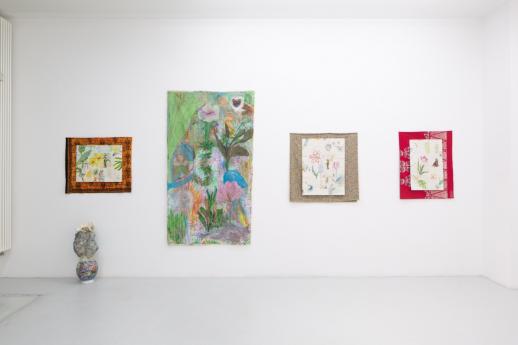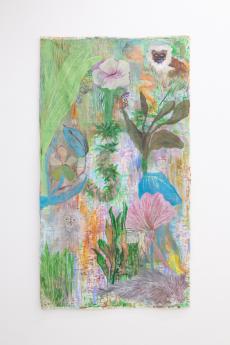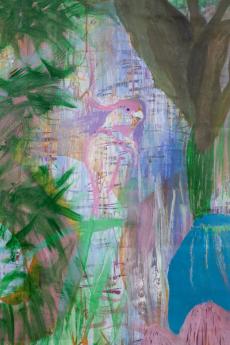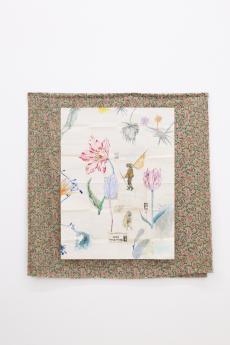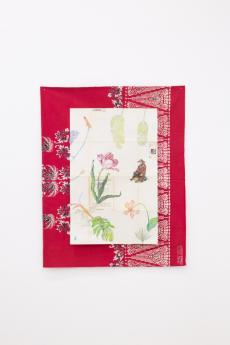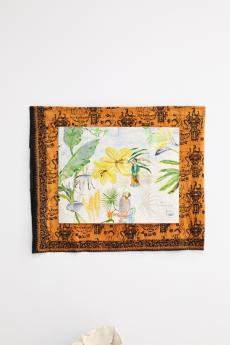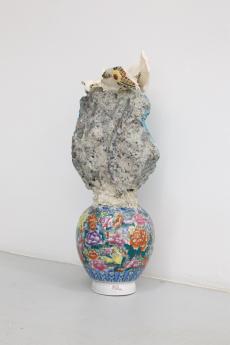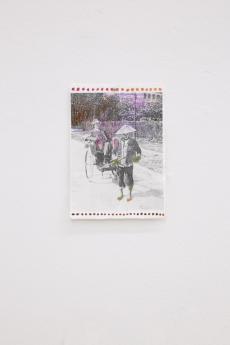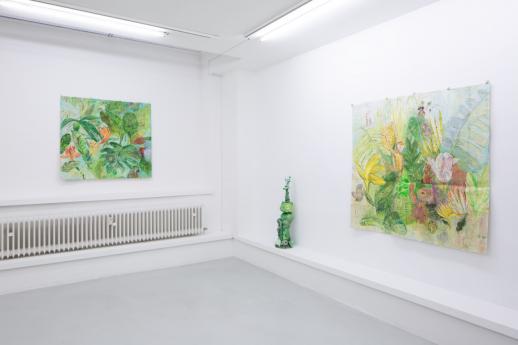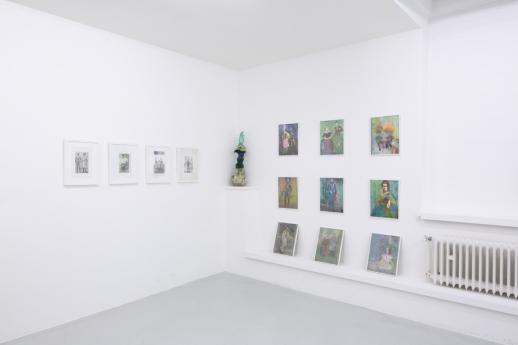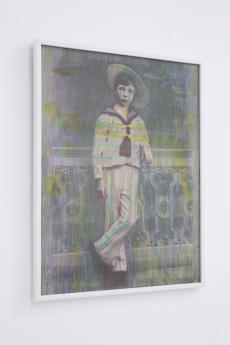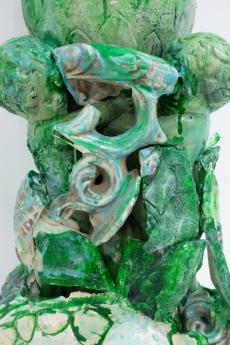ALIKI PALASKA / SAY IT SOFTLY
BackALIKI PALASKA / SAY IT SOFTLY
In der neuen Ausstellung von Aliki Palaska verweben sich florale Fragmente, historische Dokumente und koloniale Bildzitate zu poetischen, aber nicht unpolitischen Bildräumen. Die Künstlerin arbeitet mit großformatigen Leinwänden und alten, ausgebreiteten Landkarten, auf denen sie üppige, beinahe überwältigende Vegetationen entfaltet. Sie lädt die Betrachtenden ein in ein tropisches Universum, das gleichermaßen Verheißung und Fiktion, Natur und Konstruktion ist. Pflanzen, Tiere und menschliche Figuren verschmelzen zu einem dichten, rhythmisch bewegten Gewebe aus Farbe und Linie – ein vibrierendes Zusammenspiel von Chlorophyllgrün, Gelb, Türkis und Orange. Es gibt kein zentrales Motiv, keine lineare Erzählung. Vorder- und Hintergrund lösen sich auf, und zwischen den Pflanzen und Tieren öffnen sich kleine Szenenbilder, die wie Fenster in ferne Zeiten oder Geschichten wirken. Das Vegetative wird hier nicht naturalistisch, sondern emotional verstanden: Palaska inszeniert ein Spannungsfeld zwischen menschlicher Aneignung, kolonialer Unterwerfung und der Unbändigkeit der Natur.
In ihren Arbeiten greift Aliki Palaska auf Bildtraditionen zurück, die sowohl an die exotistischen Phantasien des 19. Jahrhunderts als auch an die tropischen Paradiese der europäischen Moderne erinnern. Doch wo Maler wie Gauguin oder Rousseau koloniale Vorstellungen von Unschuld und Ursprünglichkeit reproduzierten, dekonstruiert Palaska diese Mythen behutsam. Ihre „Dschungelbilder“ sind keine Fluchten in eine andere Welt, sondern poetische Reflexionen über unsere Wahrnehmung von Natur, Ferne und kultureller Projektion. So verbindet Palaska eine sinnliche Freude an Farbe und Form mit einer subtilen Auseinandersetzung mit eurozentrischen Blickregimen und kolonialen Machtverhältnissen.
In anderen Arbeiten kombiniert die Künstlerin fein gezeichnete florale Motive, die an die Zeichnungen aus botanischen Lehrbüchern erinnern, mit einzelnen militärisch anmutenden Figuren. Die Künstlerin nutzt die Ästhetik der botanischen Illustration, legt dabei aber auch ihre ideologischen Verstrickungen offen. Pflanzenkunde war im Zeitalter der europäischen Expansion keine neutrale Wissenschaft – sie diente der Aneignung, Klassifizierung und Kontrolle von Natur und Wissen. Botanische Zeichnungen wurden zu Werkzeugen imperialer Macht, indem sie fremde Territorien und deren Ressourcen katalogisierten. Zwischen Blüten, Archivspuren und angedeuteten Militärs scheint Aliki Palaska ein fragiles Gleichgewicht aus Schönheit und Kritik anzustreben.
Für weitere Werke greift sie auf historische Fotografien zurück, die koloniale Machtverhältnisse dokumentieren – Bilder, die ursprünglich als Zeugnisse imperialer Ordnung und rassistischer Hierarchien entstanden. Diese Abbildungen verfremdet sie durch zeichnerische und collagierte Eingriffe, durch Übermalungen, Übertreibungen und farbliche Akzentuierungen, wodurch sie ihre Bildsprache aufbricht. Die Bilder zeigen Personen, die koloniale Gewalt repräsentieren, zugleich aber in Palaskas Darstellungen – mit grünen Gesichtern, violetten Händen, glotzenden Augen – zu beinahe absurden Figuren werden. Die farblichen Übermalungen wirken wie Masken, das Groteske der Inszenierung von Macht deutlich. Die Werke in „say it softly“ bewegen sich zwischen sinnlicher Überfülle und kritischem Unbehagen und öffnen einen Raum, in dem sich Erinnerung und Imagination begegnen.
––––––––––––––––––––––––––––––––––––––––––––––––––––––––––––––––––––––––––––––––––––
ALIKI PALASKA / SAY IT SOFTLY
In Aliki Palaska's new exhibition, floral fragments, historical documents and quotations from colonial imagery interweave to create poetic yet political pictorial spaces. Working with large-format canvases and old, spread-out maps, the artist unfolds lush, almost overwhelming vegetation. She invites viewers into a tropical universe that is both promise and fiction, nature and construction. Plants, animals and human figures merge into a dense, rhythmically moving fabric of colour and line — a vibrant interplay of chlorophyll green, yellow, turquoise and orange. There is no central motif or linear narrative. The foreground and background dissolve and small scenes open up amongst the plants and animals, acting as windows into distant times or stories. Here, the vegetal is understood not naturalistically but emotionally—Palaska stages a field of tension between human appropriation, colonial domination, and the untamed vitality of the natural world.
In her work, Palaska draws on pictorial traditions that recall both the exotic fantasies of the 19th century and the tropical paradises of European modernism. Yet, where painters such as Gauguin and Rousseau reproduced colonial notions of innocence and primitivism, Palaska gently deconstructs these myths. Her „jungle paintings“ are not escapist visions of another world but poetic reflections on our perception of nature, distance, and cultural projection. In this way, she combines a sensual delight in color and form with a subtle critique of Eurocentric ways of seeing and colonial power structures.
In other works, Palaska juxtaposes finely rendered floral motifs—reminiscent of botanical textbook illustrations—with isolated, military-like figures. While adopting the aesthetics of botanical illustration, she also exposes its ideological entanglements. During the era of European expansion, botany was far from a neutral science; it served to appropriate, classify, and control both nature and knowledge. Botanical drawings became instruments of imperial power, cataloguing foreign territories and their resources.
Elsewhere, she turns to historical photographs that document colonial power relations—images originally produced as evidence of imperial order and racial hierarchy. Palaska transforms these depictions through drawing, collage, overpainting, exaggeration, and color interventions, breaking open their visual logic. The images show people who represent colonial violence, but at the same time, in Palaska's depictions—with green faces, purple hands, and staring eyes—they become almost absurd figures. The colorful overpaintings act like masks, exposing the grotesque staging of power. The works in Say It Softly oscillate between sensual excess and critical unease, opening up a space where memory and imagination converge.
Copyright © 2025 Françoise Heitsch, All rights reserved.
Aliki Palaska
/
Biography
MFA Concodia Universitiy, Montreal
Solo Exhibitions
Group Exhibitions
"Revalue/ I.Part" / Galerie Francoise Heitsch, Munich
"Buffet"/ Martinos Antique and Fine Art Gallery, Athen
"Through the looking glass"/ Martinos Antique and Fine Art Gallery, Athen
"Zoo"/ Martinos Antique and Fine Art Gallery, Athen
"During the eclipses art mates"/ Camp, Athen
"Kiss from Greece"/ Womachine Galerie, Berlin
"Kiss from Greece"/ Stalger Galerie, Wien

